Septum Piercing in Nairobi, Kenya
A septum piercing is a type of body piercing that goes through the soft tissue (also known as the “sweet spot”) between the nostrils at the base of the nose. This location, called the nasal septum, is the thin membrane of skin that separates the two nostrils. Unlike nostril piercings, which go through the side of the nose, a septum piercing is centered and positioned at the lower part of the nose.
Septum Piercings
Septum piercings appeal for their unique look, flexibility with jewelry options, and sometimes their cultural significance. They are seen as a modern yet subtle way to express individuality, and the ease of hiding the jewelry makes them a suitable choice even in professional environments.
- Appearance: The piercing typically sits in the center of the nose, giving a symmetrical and balanced look that can suit various jewelry styles, like circular barbells or seamless rings.
- Popularity: Known for its versatility, the septum piercing can be bold or discreet. It’s popular in modern fashion and has roots in various cultural traditions worldwide.
Key Points for Septum Piercings
- Pain Level: Generally rated moderate, as the septum piercing goes through a thin layer rather than cartilage.
- Healing Time: Typically takes about 6-8 weeks, though complete healing may take up to 6 months.
- Jewelry Choices: Common jewelry includes circular barbells, captive bead rings, or seamless rings. Some opt for horseshoe rings that can be flipped up and hidden if needed.
- Aftercare: Clean with saline solution twice daily, avoid touching or rotating the jewelry, and steer clear of makeup or creams near the piercing site during healing.
Septum Piercings Procedure
The septum piercing procedure involves a few key steps to ensure safety, precision, and comfort. Here’s a breakdown of the typical process:
- Preparation and Hygiene
– Choosing a Professional: At Rebel Inks Tattoos, Tattoo Removal, and Body Piercings Parlour we have a team of professional and experienced piercers with septum piercings. Our studio uses sterile equipment, working in a clean environment to minimize the risk of infection.
– Sterilization: Before starting, our piercer sterilizes the area around the septum and ensures that all tools and jewelry are clean and sanitized. - Marking the Spot
– Finding the Sweet Spot: Our piercer will locate the “sweet spot,” a small, thin membrane of skin just below the cartilage. This area is ideal because it’s softer and less painful to pierce.
– Marking: Using a surgical pen, our piercer marks the exact spot where the needle will go, ensuring proper alignment and symmetry. - Piercing Process
– Clamping: Our piercer may use a clamp to hold the septum in place, helping keep it steady during the procedure.
Insertion: A hollow, single-use needle is used to pierce through the septum. This is done quickly to minimize discomfort.
– Jewelry Placement: Once the piercing is complete, our piercer will insert the initial jewelry (usually a circular barbell or a captive bead ring) into the hole. - Aftercare Instructions
– Cleaning Tips: Our piercer will provide instructions on cleaning the area twice a day with a saline solution, avoiding touching the jewelry unnecessarily, and keeping the area dry.
– Healing Period: The septum piercing typically takes 6-8 weeks to heal, though full healing can take several months.
Pain and Discomfort
While the pain is often described as a sharp pinch, it varies by individual. Most people experience some tenderness and swelling in the first few days, which usually subsides with proper care.
Considerations before getting a Septum Piercing
Getting a septum piercing is a significant decision, and there are several important considerations to keep in mind before going through with the procedure. Here are some key factors to think about:
- Piercing Studio Selection
– Research reputable piercing studios or professional piercers in your area. At Rebel Inks Tattoo Removal and Piercings Parlour we have a team of professional body piercing experts that can and have successfully done many Septum Piercings Contact Us Today for any inquiries.
– Read reviews, ask for recommendations, and visit the studio in person to assess its cleanliness and professionalism. - Piercer Qualifications
– Ensure that your piercer is experienced, licensed, and trained in septum piercings.
– Ask about their qualifications and request to see their portfolio of previous work. - Placement and Style
– Discuss the placement of the septum piercing with your piercer to ensure it’s in the desired location and suits your facial features.
– Consider the style of jewelry you want, such as a circular barbell, captive bead ring, horseshoe, or septum clicker. - Pain Tolerance: Understand that pain perception varies from person to person. Most people describe septum piercings as moderately uncomfortable but relatively quick.
- Healing Time and Aftercare
– Septum piercings typically take 6 to 8 weeks to fully heal. During this time, proper aftercare is crucial.
– Commit to cleaning the piercing regularly with saline solution and avoiding touching it with dirty hands. - Initial Jewelry: The initial jewelry may be slightly larger to accommodate for swelling during healing. You can downsize to a smaller piece once the piercing has healed.
- Flip-Up Option: One advantage of a septum piercing is that you can flip the jewelry upward into your nostrils when needed, making it less visible.
- Infections and Complications: Be aware of the potential risks, including infection, migration, or rejection. Know the signs of infection and seek medical attention if necessary.
- Jewelry Maintenance: Regularly clean your septum jewelry to prevent buildup of bacteria and debris. Clean it gently with saline solution or warm water.
- Lifestyle and Social Considerations
– Consider how a septum piercing may impact your daily life, including work or school environments with dress code policies.
– Think about your own comfort level with the visibility of the piercing in different settings. - Allergies: If you have known allergies or sensitivities to certain metals or materials, discuss this with your piercer to select suitable jewelry.
- Personal Style: Ensure that a septum piercing aligns with your personal style and aesthetic preferences.
- Commitment: Keep in mind that removing a septum piercing may result in some scarring or visible hole closure.
Septum piercings are a form of self-expression, and your comfort and preferences should be top priorities. Take your time to make an informed decision, consult with your piercer, and ask any questions or express concerns you may have before getting a septum piercing.
Septum Piercings FAQ’s
Pain and Healing for a Septum Piercing
A septum piercing is often considered moderately painful but manageable. Here’s what to expect in terms of pain and the healing process:
Pain Level
- Initial Pain: The piercing itself is generally a quick, sharp pinch, lasting only a second or two. For many, the experience is similar to tearing up slightly, as the nose is sensitive and often reacts that way.
- Tenderness Afterward: Right after the piercing, it’s common to feel a dull ache or throbbing around the area, which usually subsides within a few hours. Some soreness can linger for a few days, especially if the piercing is accidentally bumped.
Healing Process
- Early Healing (0-2 Weeks):
– Initial swelling, tenderness, and possible minor bleeding are typical.
= Avoid touching or twisting the jewelry, as this can disrupt healing. - Intermediate Healing (2-6 Weeks):
– Swelling should go down, and tenderness gradually lessens. It’s crucial to continue regular cleaning during this stage.
– Some crusting around the jewelry may occur. This is normal and can be gently cleaned with saline solution. - Long-Term Healing (6 Weeks-6 Months):
– While the outer tissue generally heals within 6-8 weeks, full healing internally can take several months.
– You may be able to change jewelry after the first two months, but consult your piercer to avoid complications.
Common Healing Issues
Minor swelling and occasional crusting are normal, but if you experience increased pain, redness, or discharge, it could be a sign of infection. In such cases, consult a professional piercer or healthcare provider.
Septum Piercing Aftercare
Proper aftercare is essential for a healthy and quick recovery from a septum piercing. Here’s a complete guide on aftercare practices to follow:
- Daily Cleaning Routine
– Saline Solution: Clean the piercing twice daily with a sterile saline solution. You can buy a pre-made saline wound wash or make one by mixing 1/4 teaspoon of non-iodized sea salt with 1 cup of warm distilled water.
– Application: Use a cotton pad soaked in saline to gently dab around the piercing. Avoid using harsh soaps, hydrogen peroxide, or alcohol, as these can irritate the area.
– Gentle Cleansing: If any crust forms around the jewelry, gently remove it with a saline-soaked pad. - Avoid Touching and Twisting
– Hands Off: Try to keep your hands off the piercing to prevent transferring bacteria. If you must touch it, wash your hands thoroughly first.
– Avoid Twisting: Unlike some other piercings, a septum piercing does not need to be rotated. Twisting or fiddling with the jewelry can damage the delicate tissue and prolong healing. - Be Mindful of Your Environment
– Avoid Submersion: Keep the piercing out of pools, hot tubs, and any water that might carry bacteria until it’s healed.
– Protect During Sleeping: Sleep on your back if possible to prevent bumping the piercing. Avoid pressing your face into pillows, which can irritate the piercing. - Reducing Swelling and Pain
– Cool Compresses: A cool, clean cloth or ice pack wrapped in a towel can help reduce swelling if the area feels sore. Use it for short intervals as needed.
– Avoid Irritants: Avoid applying makeup, creams, or lotions around the nose. Try to keep the piercing clear of any skin or hair products. - What to Watch For
– Healing Progress: Initial healing usually takes 6-8 weeks, but complete healing can take several months. Signs of progress include reduced tenderness and less crusting.
– Signs of Infection: Increased redness, warmth, discharge, and persistent swelling or pain are signs of a potential infection. If you suspect an infection, consult a professional piercer or healthcare provider promptly. - Jewelry Changes
– Waiting Period: Wait at least 8 weeks, preferably longer, before considering a jewelry change. Consult your piercer first to ensure your piercing has healed sufficiently.
With these steps, your septum piercing should heal well, allowing you to enjoy your new look comfortably! Let me know if you need more tips or have any concerns.
Septum Piercing Jewelry
Septum piercing jewelry comes in a variety of styles, materials, and sizes to suit different preferences and aesthetics. Here’s an overview of popular jewelry types, ideal materials, and sizing recommendations for septum piercings:
Popular Types of Septum Jewelry
- Circular Barbells:
– These are horseshoe-shaped and popular for initial piercings.
– The shape allows for easy cleaning and can be flipped up into the nose if you need to hide the piercing. - Captive Bead Rings (CBRs):
– A classic, seamless ring with a bead that snaps into place.
– Provides a bold, continuous look but can be slightly harder to clean due to its closed design. - Seamless Rings:
– Also called continuous rings, these have no visible break or bead, giving a smooth, minimalist appearance.
– Can be a bit tricky to remove, so they’re best suited for healed piercings. - Clickers:
– These feature a hinge that allows the jewelry to “click” into place, making them easy to put on and remove.
– Clickers come in various designs, including gem-studded or patterned, offering more decorative options. - Septum Retainers:
– A U-shaped piece designed to hide the piercing. These can be flipped up into the nose for a completely discreet look.
– Ideal for individuals who want a hidden piercing for work or other settings.
Recommended Materials
- Surgical Steel: Durable and hypoallergenic, surgical steel is a popular option for septum jewelry. It’s safe for initial piercings and long-term wear.
- Titanium: Another hypoallergenic choice, titanium is lightweight and highly resistant to corrosion. It’s often recommended for those with sensitive skin.
- Niobium: This material is similar to titanium but slightly softer. It’s great for sensitive skin and safe for new piercings.
- Gold: Choose only 14k or higher gold for septum piercings to avoid irritation. Gold jewelry can add a touch of luxury but is best for healed piercings.
- Acrylic or Silicone: These materials are often used for retainers but should only be used in fully healed piercings due to the potential for bacterial buildup.
Sizing Guide
- Gauge: Septum piercings typically use 16g (1.2mm) or 14g (1.6mm) jewelry for initial piercing. Thicker gauges, like 12g or 10g, are possible for those who prefer a bolder look.
- Diameter: The size of the jewelry’s diameter will depend on your anatomy and the desired look. Common diameters range from 8mm to 10mm, but consult with your piercer to find the best fit.
Choosing Your Jewelry
When choosing jewelry, consider your lifestyle, aesthetics, and the healing stage of your piercing. For a low-maintenance and discreet option, circular barbells and retainers are excellent choices. If you want a more decorative look, explore clickers or CBRs once the piercing is fully healed.
Cost of a Septum Piercing in Nairobi, Kenya
The cost of a septum piercing can vary depending on several factors, including the studio location, piercer’s experience, and jewelry choice. Here’s a general breakdown of what to expect:
Average Price Range
- Typical Range: Ksh. 1,500 to Ksh. 2,500 is common in most places for a basic septum piercing, with high-end studios or well-known piercers potentially charging more.
- Jewelry Costs: The initial jewelry is often included in the price, but upgrades (e.g., titanium or gold) may add Ksh. 300 to Ksh. 1,000 or more to the total cost.
Septum Piercing Cost Breakdown Table & Price Ranges
Price Tier | Estimated Cost (KES) | What’s Included / Details |
Budget / Basic | 1,200 ‒ 1,500 | Procedure + basic surgical steel jewelry; minimal aftercare (just verbal instructions) |
Standard | 1,500 ‒ 2,500 | Procedure + starter jewelry (steel, possibly basic titanium); aftercare advice; maybe a small aftercare kit |
Upgraded Jewelry | 300 ‒ 1,000 | If you choose titanium, gold-plated, custom rings, thicker gauge, decorative ends, etc. |
Full Service / Premium | 2,500 ‒ 4,000 | Including premium jewelry, detailed consultation, good aftercare kit (saline, cleanser), check-ups, possibly higher cost for experienced piercer or upscale studio |
Factors Affecting the Price
- Studio Location: Major cities or areas with higher living costs generally have pricier services. Rebel Inks Tattoos, Tattoo Removal, and Body Piercings Parlour is located in the heart of the Central Business Disrict (CBD) in Nairobi, Kenya, and is easily accessible to both locals and foreigners in the country.
- Piercer Experience: Highly experienced piercers with good reputations may charge more for their expertise and attention to detail. At Rebel Inks Tattoos, Tattoo Removal, and Body Piercings Parlour we have experienced professionals who offer quality and premium services.
- Jewelry Material: Basic surgical steel is often included in the initial piercing price, but opting for high-quality materials like titanium or gold will increase the cost.
- Aftercare Kit: At Rebel Inks Tattoos, Tattoo Removal, and Body Piercings Parlour we provide an aftercare kit (saline solution, instructions, etc.), either included in the price or as an add-on for an extra fee, usually around Ksh. 300 to Ksh. 1,000.
Additional Costs
- Follow-Up Appointments: Some studios offer free check-ups, while others may charge if you need an additional consultation or jewelry adjustment.
- Jewelry Change: If you return to our studio to have jewelry changed once healed, there may be a small fee, especially if new jewelry is purchased.
It’s best to choose a reputable, clean studio even if it’s on the higher end of the price range. This ensures better safety and quality, reducing the risk of complications.
Possible side effects of Septum Piercing
A septum piercing, like any body modification, can come with potential side effects. While most can be managed with proper care, it’s essential to be aware of these risks before getting pierced.
Common Side Effects
- Swelling and Tenderness:
– Initial swelling and tenderness around the piercing site are typical, lasting a few days to a week. This is the body’s natural response to the piercing process.
– Over-the-counter pain relievers and a cool compress can help reduce swelling. - Minor Bleeding:
– Some bleeding is common immediately after the piercing and may persist for a few days.
– Avoid touching the piercing unnecessarily, as this can prolong bleeding and slow healing. - Crusting and Discharge:
– As part of the healing process, it’s normal for a clear or pale yellow discharge to form and dry around the jewelry. This crusting should decrease over time.
– Gently clean with saline to keep the area clear of buildup.
Less Common but Potential Side Effects
- Infection:
– Signs of infection include redness, warmth, swelling, intense pain, and yellow or green discharge. Infections are often due to poor hygiene or touching the piercing with unclean hands.
– To prevent infection, follow a strict cleaning routine and avoid submerging the piercing in potentially contaminated water (like pools or hot tubs). - Septal Hematoma:
– This occurs when blood accumulates between the cartilage and the membrane in the septum, leading to swelling, pain, and a feeling of pressure in the nose.
– A hematoma requires medical attention to prevent complications, including potential nasal structure issues. - Allergic Reaction:
– Some people may be allergic to certain metals, especially nickel. Hypoallergenic metals like titanium, surgical steel, and niobium are recommended for those with sensitive skin.
– Symptoms of an allergic reaction include itching, redness, and a rash around the piercing site. - Scarring and Keloids:
– While scarring is rare with septum piercings, some people may develop hypertrophic scars or keloids if they’re prone to them.
– Proper care and avoiding trauma to the area can minimize the risk of scarring. - Piercing Migration or Rejection:
– Rarely, the body may recognize the jewelry as a foreign object and push it out, leading to migration or rejection.
– Choosing high-quality jewelry and consulting with an experienced piercer can help reduce the risk.
Long-Term Side Effects
- Septum Deviation: Although uncommon, some people report changes in the shape of their septum after piercing, particularly if the piercing was improperly placed.
- Smell: As with any body piercing, septum jewelry can sometimes harbor bacteria, causing an odor if not cleaned regularly.
How to Minimize Risks
- Choose a Reputable Piercer: An experienced piercer will follow safety and hygiene protocols and ensure proper placement.
- Follow Aftercare Instructions: Consistent and gentle aftercare is key to a successful healing process.
- Avoid Trauma: Bumping, twisting, or snagging the jewelry can increase healing time and lead to complications.
If you experience any unusual pain, prolonged swelling, or discharge, consult a healthcare provider or your piercer to address potential issues early. Let me know if you need guidance on managing any specific symptoms or concerns.
Get In Touch
For more information on the list above and any other special services,please call or come in for free consultation
Testimonials
After he pierced my industrial piercing and seeing his amazing work, I feel even more excited about getting my tattoo with him in January. I’m really looking forward to it!
I am extremely happy with my new 'Safari' tattoo from Eric at Rebel Inks! The quality of the artwork is fantastic. Eric is a true professional and an amazing artist.
The preparation and design process was thorough and collaborative. He was very patient with my specific requests, including making sure all the elements, which hold personal meaning, were perfect.
The service was friendly and highly professional from start to finish. Despite the 8-hour session, Eric was a pleasant person to spend the time with.
The aftercare guidance and follow-up have been excellent and careful, which has made the healing process easy and better than expected.
I highly recommend Eric for anyone looking for a thoughtful, talented, and caring tattoo artist.
I recommend them 💯
I would definitely recommend if you’re thinking of getting a piercing!
The staff were super friendly, explained everything clearly, and made me feel so at ease. They answered all my nervous questions (and I had many questions),
They walked me through the whole process, gave detailed aftercare instructions, and even followed up afterward to check how I was healing 🫶
Clean, professional, and full of good vibes.
Would 100% recommend . Definitely making a second trip here.
This was the second tattoo I got and I wish I could have come to Eric for my first one! He gave me really great after-care directions for the tattoo as well as a little jar of his own Vaseline-type stuff to put over my tattoo while it was healing! He even put second skin over my tattoo so that I didn’t have to worry about it for the first few days. Now THAT’S good service. My first tattoo artist didn’t do none of that lol.
After the session Eric didn’t rush me and my friend out, he chatted with us and even when he found out I was an artist too— really encouraged me to keep creating and to find a community of artists to support me. I almost cried because I’ve had such a hard time with my own art the past couple of years, it meant so much to me to have a fellow very talented artist say that to me. 🤍🤍🤍
Eric you’re amazing, don’t ever stop creating and just know you’ve impacted lives all over the world!🫶🏻 thanks so much for everything!!
From the moment I walked in, Eric was professional, welcoming, and attentive. He made sure I was comfortable throughout, provided everything I needed, and explained every step of the process. The tattooing itself was unbelievably smooth - I genuinely felt no pain compared to my previous tattoos over the last 22 years.
Eric also gave me excellent aftercare guidance and products, and thanks to that, my tattoo healed beautifully. The attention to detail, precision, and shading are absolutely stunning. This is hands-down the best tattoo I've ever had, and I will be flying back to Nairobi for any future ink.
If you want incredible art, a professional experience, and a talented artist who truly cares about his clients, Rebel Ink is the place to go!
From start to finish, the service was exceptional. The piercer was professional, knowledgeable, and made me feel completely comfortable. The cleanliness of the place was above and beyond — everything was spotless and hygienic, which really put me at ease. Highly recommend for anyone considering a piercing!
Shout out to Eric😘
We ended up changing the jewelry three times to ensure I had the best fit and avoided any signs of rejection, and he always listened to my suggestions as a client, which I really appreciated. Now, three months in, my piercing is healing beautifully, with no sign of rejection. Highly recommend for anyone who values a piercer who cares about your comfort and healing journey!
What stood out the most was the aftercare Eric checked in with me even three weeks later to see how the tattoo was healing. That kind of follow-up shows how much he truly cares about his work and his clients.
I’m very satisfied and will definitely be coming back for my next piece. Highly recommend!
The piercing wasn't as painful as I had thought and the process was quick and satisfactory. I love it!!!
The piercing is healing well thanks to the aftercare instructions and follow-up. I would highly recommend Rebel Inks
Eric also did a belly button piercing for a friend, guiding her through the process, doing the piercing and then explaining the after care to her.
The shop is on the 3rd floor, with the entrance to the stairs near an alleyway on the left. The shop is perfect size, clean, and attractive looking. The mural is pretty dope.
Thank you for the amazing service! 🔥👅✨
I got piercibgs there and the process was really good. My biggest concern was hygiene but that wasn't an issue at all, they use new needles and they sanitize them.
The service itself was also welcoming.
I was informes of everything i needed to know beforehand.
10/10 would recommend!
Eric was so calm and patient with my almost 2 year old lady. It was such a clean and hygienic process. We will definitely be back for our second rounds of piercings and maybe even another tattoo!
They assess the area before any art and advise one accordingly. They also give one post clean up process and also do a check up after the body art projects. Overall, I loved my experience and I’m hooked. 👍
Will definitely come back next time I’m in town 🙂
He listened to what I actually wanted and made sure he could fit in the time before I flew back home.
The shop is clean & private and is easy enough to find.
Eric has even checked in a couple of times since to make sure all is good.
I would totally recommend Eric! I absolutely love my Elephants!
I had a very easy healing period and always follow up from Eric to check on my progress...I would highly recommend if you are a first timer because from my experience all went very well and attention to detail
Thank you for a good job and looking forward to send all my friends your way
And all the best with the new year 2025!
From the moment I walked in, the staff was super friendly and made me feel at ease. The studio had a clean, professional atmosphere, which immediately put me at ease. My piercer was incredibly skilled and explained every step of the process, ensuring I was comfortable the entire time. The piercing was quick and practically painless, and the aftercare instructions were clear and easy to follow. I can tell they really care about the health and safety of their clients.
Overall, a fantastic experience—I highly recommend Rebel Inks and Tattoos for anyone looking to get pierced or tattooed!
They do follow up after their services
Eric's Studio isn’t just a place to get a tattoo—it’s an experience. The combination of professionalism, artistic talent, and a welcoming environment makes it a standout destination for anyone considering a tattoo.
I highly recommend Eric’s Studio to both first-timers and seasoned tattoo enthusiasts. If you’re looking for a high-quality tattoo and an enjoyable experience, this is the place to go.
I would definitely recommend their services again and again
Thank you Rebel Ink
My piercings are healing ❤️🩹 well
I would 💯 recommend
I will definitely come back for more .
Two, all the equipments he used for the piercings were new and/or sterilised.
Three, the parlour itself was very clean and was up to par with the hygiene standards.
Four, Eric provided effective aftercare instructions, making sure I knew exactly how to take care of my new piercings and he kept in touch and continues to do so, to check on the healing progress.
I highly highly highly recommend this place!!!
Would definitely recommend them to friends and go back for other piercings
Not only was the piercing process smooth, but he also provided thorough aftercare instructions, making sure I knew exactly how to take care of my new piercings. What really impressed me was that he keeps in touch to check on how the healing is progressing – a sign of true care for his clients.
The shop maintains a high standard of hygiene, and the atmosphere is welcoming and comfortable, which really added to the positive experience. I highly recommend this place to anyone looking for a professional and caring experience. I’ll definitely be coming back for any future piercings!
My appreciation for the excellent customer service I received. The follow-ups were prompt, and I truly appreciated the gentleness and professionalism throughout. Thank you!"
"Looking for professional eyebrow microshading removal? Look no further!"
The customer care is top tier 👌🏾👌🏾.
Wonderful place to get tattoos and piercings. 💯💯
Eric goes ahead to follow up on his clients progress and gives good advice each time I reach out to him.
I would recommend Reble tattoos anytime.
Good job bro we really appreciate.
Ohh and the price is very fair.
The environment was clean , procedure was sterile and the jewelry used are of the best quality.
He followed up with me during the healing process, he educated me on what I needed to do for my aftercare.
Eric is confident, skilled , experienced and the best piercer. Highly recommend Rebel inks.✨
Definitely recommend!
Great experience.
Eric definitely know what he is doing .
I got exactly what I wanted 2 tiny tats on the same finger .
He was kind and patient throughout the session.
Healing process has been good .
Aftercare services were given and regular checkups on the healing process were done.
I would 💯recommend.
Eric gave me the best reception as it was my first time there,and made me trust him all the way. I appreciate good services.
There services are also affordable not to forget 😊.
He was also invested in the aftercare and would ensure I follow the do's and don'ts in taking care of the tattoo and ensuring proper healing and maximum ink retention.
Would highly recommend Rebel Inks Tattoos.
Rebel Inks Tattoo offer the best,affordable and quality tattoo removal services.If you have unwanted ink,choose Rebel Inks Tattoo,they're the best of the best and the professionalism is a top notch.They ensure you're free from unwanted ink with their Laser Tattoo Removal Technology...
I did a Laser Tattoo Removal with them and i can attest they're the best....
Kudos Eric...
I highly recommend.
It was a generally good experience with good hygiene during the piercing process and has been a smooth healing process.... 10/10
tips. Highly recommend 👍🏽
100% recommendable.
I was particularly impressed with Eric's attention to hygiene. He thoroughly cleaned the room before I entered, sanitized all of the equipment he would be using, and changed gloves between each ear. This level of cleanliness gave me great confidence in his professionalism.
Eric's commitment to customer service did not end on the day of the piercing. He followed up with me regularly throughout the healing process to ensure that I was following the aftercare instructions and that my earlobes were healing properly.
I highly recommend Rebel Inks to anyone in Nairobi who is considering getting a piercing. Eric is a highly skilled and experienced piercer who takes great pride in his work.
So I Check all the boxes below and more:
Customer Care: ✔️
Professionalism : ✔️
Cleanliness ✔️
Price: ✔️
After care service ✔️
Thanks and good job, Eric
The place is neat and clean and the equipments he used were also fine standards. Really appreciate his following up with me on the healing 🤗
I WOULD HIGHLY RECOMMEND THEIR SERVICES to everyone. Actually what you see on their website is EXACTLY what you will get. Keep up the good work Rebel inks Tattoos.
The infection is now gone. I would definitely recommend!
Can recommend this place totally and would go back there anytime!
Thanks!
OUR LOCATION
Areas We Serve
NAIROBI
KIAMBU
KAJIADO
MACHAKOS
























































































































































































































